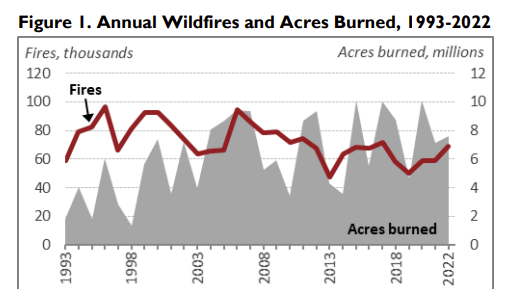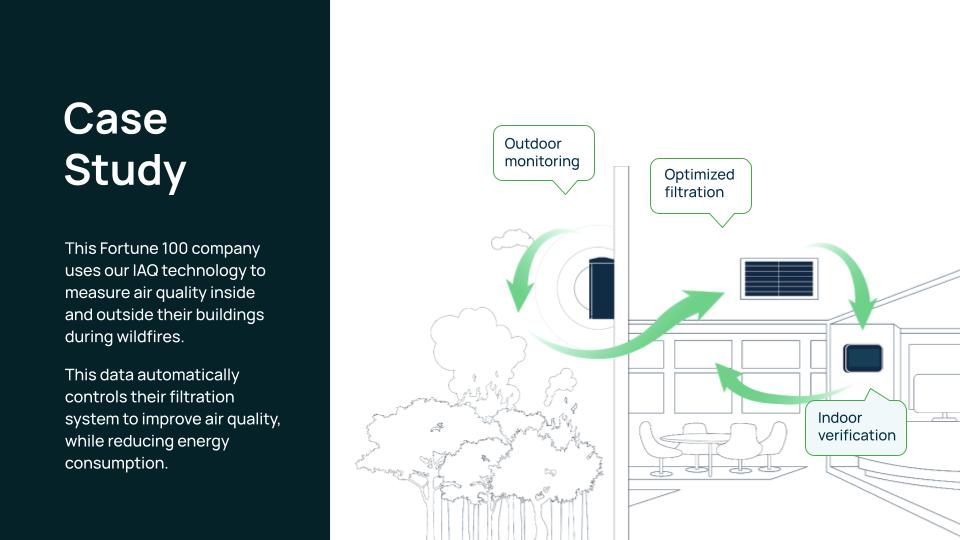Newsletter
(Image source: Christopher Michel via Wikimedia Commons)
Wildfires are among the most severe and devastating challenges that global warming poses, and this is largely due to their impact on air quality. You would once have been forgiven for assuming that these disasters were mostly a problem elsewhere. However, the US now suffers annual economic losses from wildfires that are twice as high as any other nation, with disastrous consequences for the country’s air quality. Read on to learn how to manage indoor air quality (IAQ) in your building when disaster strikes.
Wildfires on the Rise
As climate change continues to make our world hotter and drier, wildfire damage has increased globally, and the US is no exception. While the average number of US wildfires has decreased since the 1990s, the number of acres burned each year has risen rapidly:

Source: Congressional Research Service Statistics (PDF)
Even more strikingly, a 2021 study shows that the average area burned by forest fires annually has grown by 1,200% since the 1970s, and that three of the worst years for forest fires in the past five decades have occurred since 2015.
It is not only US fires that harm US citizens - wildfires know no borders. In June 2023, for example, smoke from wildfires in Quebec blew down into New York and Detroit, causing New York to momentarily surpass Delhi as the world’s most polluted city. During this period, smoke shrouded the city, and state services issued facemasks to citizens, who were advised to remain indoors.
Wildfires Cause Environmental and Economic Harms
Wildfires do not just disrupt civilian life in the short term, but exacerbate climate change by destroying the carbon sinks provided by forests. The destruction of these ecosystems means that each year, sources of oxygen are depleted and CO2 levels increase, while thousands of endangered native animals and plants are obliterated.
Another critical issue posed by the fires is economic. Research by the National Bureau of Economic Research has revealed that, on average, wildfires cause US workers £125 billion of lost wages annually - equating to roughly 2% of all labor income. This is not to mention the structures regularly engulfed by the blazes. The 2020 wildfires destroyed 18,000 US buildings, of which 10,000 were homes.
Health Impacts of Wildfires
Clearly, wildfires are devastating for the environment, the economy, and US homes, but what about human health? In fact, this is the arena in which some of the most harmful impacts occur. Direct exposure to flames entails the risk of burns, heat stroke, and dehydration; but the air pollution caused by these events can cause broader and longer-lasting damage.
Wildfire-polluted air has high rates of oxidative and proinflammatory components, which can lead to extreme toxic effects in those exposed. These can include irritation to the eyes, skin, and lungs, as well as the onset of acute respiratory and cardiovascular diseases. Research also shows that populations affected by wildfire pollution exhibit higher cases of premature deaths and pneumonia. Wildfire smoke is also damaging to the brain, and can lead to higher rates of dementia and depression in affected populations. So what components does wildfire smoke contain that cause it to be so damaging?
Carbon monoxide (CO) is an odorless, colorless, tasteless gas that is released when wood and other fuels are burned. Exposure to high quantities of carbon monoxide is severely detrimental to health, and can be fatal in extreme circumstances. The damage is caused when too much carbon monoxide is in the air, causing the body to fill red blood cells with CO instead of oxygen. Symptoms of CO poisoning include headaches, blurred vision, loss of muscle control or consciousness, and amnesia.
Volatile organic compounds (VOCs) are released in high quantities during wildfires, because not all of the organic material burned during wildfires is uniformly combustible. When heated, VOCs will evaporate and disperse into the atmosphere, where they can contribute to pollution and travel over large distances.
Exposure to VOCs can cause a host of negative effects in humans, such as blurred vision, headaches, nausea, and loss of coordination. VOCs are also known carcinogens, and prolonged exposure can lead to damage to the liver, kidneys, or central nervous system. The most common VOCs found in wood smoke include:
- Aldehydes, like formaldehyde, acrolein, and propionaldehyde
- Alkyl benzenes, like toluene
- Polycyclic aromatic hydrocarbons (PAHs)
Nitrous oxide (N2O) is released by the combustion in wildfires. While N2O is used medically for its anesthetic properties, prolonged exposure can result in dissociation, disorientation, and impaired memory and cognition. This gas is also environmentally destructive, converting into nitrogen oxides in the atmosphere, which deplete the ozone layer and hasten global warming.
PM2.5 is perhaps the greatest airborne threat to human health posed by wildfires. This fine particulate matter is a mixture of chemical species, including metals, and organic and carbon compounds. Also known as black carbon or soot, the PM2.5 released by wildfires can remain in the area for months after a fire occurs, slowly polluting the air of the surrounding region.
Those exposed to PM2.5 are at risk of a range of harmful effects, including premature death, respiratory and cardiovascular diseases, asthma, and bronchitis. PM2.5 can continue to wreak havoc a long time after exposure, as the particles are small enough to become deeply embedded within lung tissue.
PM2.5 from wildfires is particularly dangerous because it can travel thousands of miles from the flames, and engulf entire regions for weeks at a time. For instance, while the EPA sets safe levels at safe levels of PM.25 at 12.0 µg/m3, the 2023 Canadian wildfires caused levels to exceed 400 µg/m3 on the streets of New York. For a more in-depth look at particulate matter, check out our Guide To Understanding Particulate Matter (PM).
Managing Indoor Air During and After Wildfires
IAQ-related solutions become crucial during wildfires, as different strategies may be needed to curb harm from air circulating outdoors. This outdoor, or ambient, air will inevitably make its way into your premises, bringing with it the host of toxic gasses and PM2.5 that wildfires produce. Your job will be to closely monitor the situation and aim to circumvent and minimize the damage. Let’s take a look at how this can be achieved.
When More Ventilation Does Not Equal Better Air Quality
There’s a common misunderstanding - which persists even among people who are professionally involved in air quality monitoring - that high ventilation rates equate to clean air. There are numerous problems with this assumption. First of all, climate change is reducing the quality of ambient air across the globe, and many cities issue smog warnings every day. In these cases, high ventilation drives this smog into less polluted indoor spaces, where employees suffer the consequences.
Wildfires perfectly illustrate this dilemma, creating conditions where the ambient air is regularly deemed dangerous for humans, and we are encouraged or ordered to remain indoors. We should use these events as learning opportunities, disasters that destabilize our notions of how to achieve clean air indoors.
Rather than expend colossal amounts of energy powering HVAC systems that may issue harmful air into our workplaces, real-time IAQ monitoring is required to determine whether ventilation will help or hinder in a given situation. If ambient air quality is poor, a range of other tactics should be applied, such as recirculation and layered filtration. This will not only prevent us from flooding our buildings with smog, but slow the climate change that HVAC plays a significant role in hastening.
In essence, we must abandon our reliance on over-simplistic ventilation rate guidelines, and utilize the available technologies to assess and make informed decisions based on empirical evidence provided by IAQ monitors.
Using Outdoor Air Quality Monitoring and Building Automation During Wildfires
While ordinarily, it may be enough to measure indoor air, during a wildfire it is advised that you monitor both IAQ and ambient air quality. Although it is sometimes possible to access ambient air quality reports online, this information can be faulty, irregularly updated, or may represent too large an area to give an accurate picture of the conditions in your exact location.
For example, a Fortune 500 Kaiterra customer uses air quality monitors both indoors and outside in order to know exactly what they are dealing with during wildfire seasons. This information allows you to adopt a range of otherwise impossible strategies, such as issuing a work-from-home order if conditions are too bad, increasing ventilation before wildfire toxins reach you, or decreasing ventilation when ambient air quality declines.

Using building automation systems (BAS) in tandem with outdoor monitors can streamline this process, allowing you to get the maximum quantity of clean air into your building when conditions worsen. You can programme these smart building systems to increase or decrease ventilation in response to PM2.5 levels, greatly reducing the amount of time spent manually adjusting HVAC dials, while putting employees’ mind at ease.
Portable Purifiers and HVAC Filters
Portable air purifiers are a valuable tool during wildfire season, as they can directly remove large quantities of PM2.5 from the air. A True HEPA air purifier is one of the most powerful varieties on the market, and is the only kind of filter that conforms to the DOE’s standards on HEPA filtration. When it comes to larger office spaces, a single purifier may not be enough, and more is certainly more when it comes to removing PM2.5 during wildfire-related spikes.
Upgrading the filters in your HVAC system is another surefire method of reducing the more harmful effects of wildfire-related pollution indoors. Once again, HEPA filters are the way to go. Look for the MERV rating that the filter carries - the higher the better. Seek out a filter with a MERV rating between 17 and 20 in order to ensure that you are removing 99% of fine particulate matter from the air.
Consider it an Investment
While the current rate of wildfires might still seem unusual, global warming trends indicate that these calamities will become increasingly prevalent in the coming years. This will likely cause periods of poor ambient air quality to become a common occurrence. In order to protect against the potentially devastating effects of toxic air on your employees, you should upgrade your equipment sooner, rather than later. You can then rest easy in the knowledge that you have done your best to prepare for the coming heavy weather.
Wildfires are on the rise in many parts of the world. For more information about wildfire smoke, including tips on how to ensure your employees are protected and remain safe and healthy, check out our article below:
5 Strategies To Keep Your Employees Safe From Wildfire Smoke






.png?width=200&height=148&name=Menu%20C%20(2).png)

.png?width=307&height=228&name=Menu%20-%20D%20(1).png)
.png)

